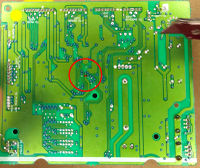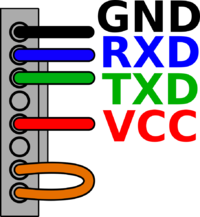Difference between revisions of "PDX2000 Firmware Upgrade"
From skratchtek
(Created page with " 1. Replace the MCU (QU01) with a HD64F3052F25 (available used from utsource) 2. Replace the Crystal (XU01) with a 25MHz one 3. Download http://rasteri.com/PDX3000_UART_SWAPS...") |
|||
| (8 intermediate revisions by the same user not shown) | |||
| Line 1: | Line 1: | ||
| + | The PDX2000/PDX2300 and PDX3000 turntables are very similar in terms of circuitry - really the only difference is in the main MCU. | ||
| + | [https://www.youtube.com/watch?v=JjtfPExJrIE The main guide is in this video.] | ||
| − | + | * '''Modify the main circuit board''' : | |
| − | + | ** Replace the MCU (QU01) with a HD64F3052F25 (available used from utsource) | |
| − | + | ** Replace the Crystal (XU01) with a 25MHz one | |
| + | ** (If you have a PDX2300) add the components RU02 (4.7KOhm) and RU27 (100Ohm). (Or just bridge their pads with solder, that's probably OK too) | ||
| + | ** Cut this trace on the bottom of the board to disconnect pin1 from VCC : | ||
| + | *** [[File:Cuttrace.png|200px]] | ||
| + | |||
| + | * '''Build a programming cable''' using an 8-pin JST PH connector and some dupont wires, this is the wiring for it : | ||
| + | ** [[File:Wiring2.png|200px]] | ||
| + | |||
| + | * '''Connect a USB-TTL serial adapter to your PC''', and connect it to JU05 (FLASH) on the Vestax PCB using the cable you just made | ||
| + | * '''[https://www.renesas.com/us/en/software-tool/flash-development-toolkit-programming-gui#download Install the renesas flash tools]''' - you want the "[Evaluation Software] Flash Development Toolkit V.4.09 Release 03" | ||
| + | |||
| + | * Run '''Flash Development Toolkit 4.09 Basic'''. | ||
| + | ** Go to "Options->New Settings" (it might automatically do this the first time you start it) | ||
| + | ** Type "H8/3052" in the filter box and select the first option in the list, click next | ||
| + | ** Select the COM port of your USB serial adapter (you can find this in Device Manager), click next | ||
| + | ** Set the CPU crystal frequency to 25MHz, click next | ||
| + | ** Make sure BOOT Mode and Use Default is selected, click next | ||
| + | ** Click Finish | ||
| + | ** Download [http://rasteri.com/PDX3000_UART_SWAPSIES.BIN THIS FILE FOR PDX2000] or [http://rasteri.com/VestHax_v1.0.bin THIS FILE FOR PDX2300], and load it into the "User/Data Area" box of the Flash Development Toolkit | ||
| + | ** Click "Program Flash", it will take 10 seconds or so. | ||
| + | ** If all is ok, it will say "Image written to device" in green - if not, check your connections and soldering | ||
Latest revision as of 14:19, 12 March 2023
The PDX2000/PDX2300 and PDX3000 turntables are very similar in terms of circuitry - really the only difference is in the main MCU.
The main guide is in this video.
- Modify the main circuit board :
- Replace the MCU (QU01) with a HD64F3052F25 (available used from utsource)
- Replace the Crystal (XU01) with a 25MHz one
- (If you have a PDX2300) add the components RU02 (4.7KOhm) and RU27 (100Ohm). (Or just bridge their pads with solder, that's probably OK too)
- Cut this trace on the bottom of the board to disconnect pin1 from VCC :
- Build a programming cable using an 8-pin JST PH connector and some dupont wires, this is the wiring for it :
- Connect a USB-TTL serial adapter to your PC, and connect it to JU05 (FLASH) on the Vestax PCB using the cable you just made
- Install the renesas flash tools - you want the "[Evaluation Software] Flash Development Toolkit V.4.09 Release 03"
- Run Flash Development Toolkit 4.09 Basic.
- Go to "Options->New Settings" (it might automatically do this the first time you start it)
- Type "H8/3052" in the filter box and select the first option in the list, click next
- Select the COM port of your USB serial adapter (you can find this in Device Manager), click next
- Set the CPU crystal frequency to 25MHz, click next
- Make sure BOOT Mode and Use Default is selected, click next
- Click Finish
- Download THIS FILE FOR PDX2000 or THIS FILE FOR PDX2300, and load it into the "User/Data Area" box of the Flash Development Toolkit
- Click "Program Flash", it will take 10 seconds or so.
- If all is ok, it will say "Image written to device" in green - if not, check your connections and soldering

